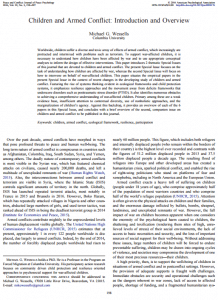This introduction to the second Special Issue on Children and Armed Conflict in the Journal of Peace Psychology aims to outline a collective vision of the mental health, psychosocial, and peacebuilding interventions needed to support war-affected children by developing a framework consisting of three central pillars: comprehensiveness, sustainability, and “do no harm”.
- Comprehensive supports should be multileveled, multidisciplinary, and necessitate a collaborative, interagency approach. Lending further insight into the Multi-Disciplinary Strategies key element, this article emphasizes a holistic schema that incorporates support to multiple levels of children’s social ecologies and puts into place functioning referral mechanisms across different levels. Complementarity should be cultivated between psychological, humanitarian, peacebuilding and economic interventions to address the various risks and sources of distress for children.
- Consistent with Outcome-Oriented Methods, sustainability can be achieved by a more locally-driven approach. Interventions should build on existing supports which reflect local values and practices, strengthen longer term capacities for ongoing holistic and community-based psychosocial support, work in a manner that shares significant power and decision-making with local partners, and enable the institutionalization of support for war-affected children.
- Lack of adherence to the “do no harm” principle is preventable with appropriate habits of critical reflection, humility, and collaboration. The article outlines several of the most common sources of unintended harm caused by interventions for war-affected children including: discrimination in terms of which areas and which beneficiaries receive support; increases in the expectations of local people; dependency by undermining natural supports and not working towards sustainable outcomes; picking open children’s psychological wounds without sufficient consideration to timing or culture. As many humanitarian interventions have unintended consequences, Continuous Context-Specific Protection Analysis enables continuous monitoring and real-time evaluation as a basis for continually examining and revising assumptions.
